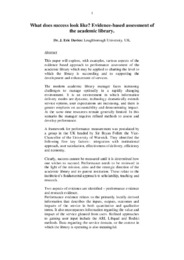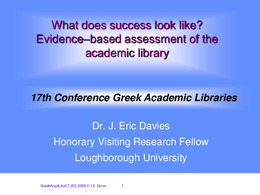| dc.contributor.author | Davies, Eric | en |
| dc.coverage.spatial | GR - Ιωάννινα | en |
| dc.date.available | 2008-09-10T12:00:00Z | el_GR |
| dc.date.issued | 2008 | el_GR |
| dc.identifier.uri | http://hdl.handle.net/10797/11451 | en |
| dc.description | Περιέχει το πλήρες κείμενο | el_GR |
| dc.description.abstract | This paper will explore, with examples, various aspects of the evidence based approach to performance assessment of the academic library which may be applied to charting the level to which the library is succeeding and to supporting the development and enhancement of services. The modern academic library manager faces increasing challenges to manage optimally in a rapidly changing environment. It is an environment in which information delivery modes are dynamic, technology dramatically extends service options, user expectations are increasing, and there is greater emphasis on accountability and demonstrating impact. At the same time resources remain generally limited. In this scenario the manager requires refined methods to assess and develop performance. A framework for performance measurement was postulated by a group in the UK headed by Sir Bryan Follett the Vice-Chancellor of the University of Warwick. They identified the following five key factors:- integration with institutional approach, user satisfaction, effectiveness of delivery, efficiency and economy. Clearly, success cannot be measured until it is determined how one wishes to succeed. Performance needs to be reviewed in the light of the mission, aims and the strategic direction of the academic library and its parent institution. These relate to the institution’s fundamental approach to scholarship, teaching and research. Two aspects of evidence are identified – performance evidence and research evidence. Performance evidence relates to the primarily locally derived information that describes the inputs, outputs, outcomes and impacts of the service in both quantitative and qualitative terms. It also encompasses information regarding the value and impact of the service gleaned from users. Refined approaches to gaining user input include the ARL Libqual and Rodski methods. Data regarding the service domain, or the context in which the library is operating is also meaningful.
Research evidence may be characterised as the generally externally sourced intelligence and macro data that informs service design and decisions. Two recent examples of broad based research evidence include the OCLC study - College students’ perceptions of libraries and information resources and the ACRL Environmental Scan 2007. Studies of more specific aspects of service can also provide valuable planning data. Another aspect of measuring success is comparative benchmarking against data available from library services in other institutions. This can be undertaken at a strategic or operational level. Some consortia, or benchmarking ‘clubs’ exist to contribute to this activity. The paper concludes by emphasizing the need for an evidence based culture to permeate an organization so that everyone involved in a service is committed to achieving and demonstrating success. | en |
| dc.language.iso | eng | en |
| dc.publisher | Πανεπιστήμιο Ιωαννίνων | el_GR |
| dc.source | Η αξιολόγηση των Βιβλιοθηκών ως στοιχείο ποιότητας των ακαδημαϊκών ιδρυμάτων - 17ο Πανελλήνιο Συνέδριο Ακαδημαϊκών Βιβλιοθηκών | el_GR |
| dc.source.uri | http://abekt.lib.ucy.ac.cy/synedria/17psab/17psab003a.pdf | en |
| dc.source.uri | http://abekt.lib.ucy.ac.cy/synedria/17psab/17psab003b.pdf | en |
| dc.title | What does success look like? Evidence-based assessment of the academic library | en |
| dc.type | Conference Object | en |
| dc.subject.JITA | Βιβλιοθήκες ως φυσικές συλλογές, Ακαδημαϊκές βιβλιοθήκες | el_GR |
| dc.subject.JITA | Libraries as physical collections, Academic libraries | en |
| dc.contributor.conferenceorganizer | Πανελλήνιο Συνέδριο Ακαδημαϊκών Βιβλιοθηκών | el_GR |
| dc.identifier.JITA | DD | en |

